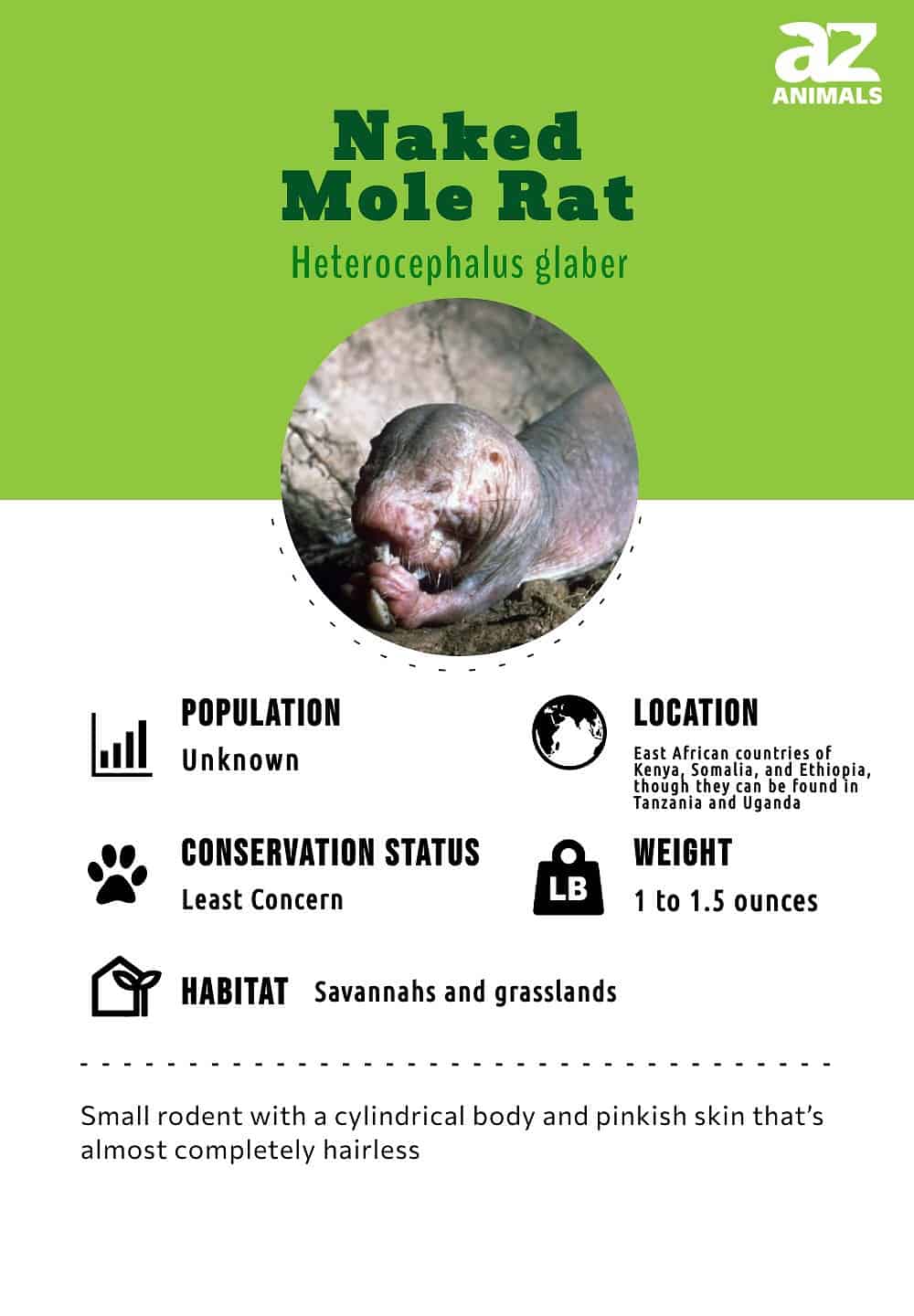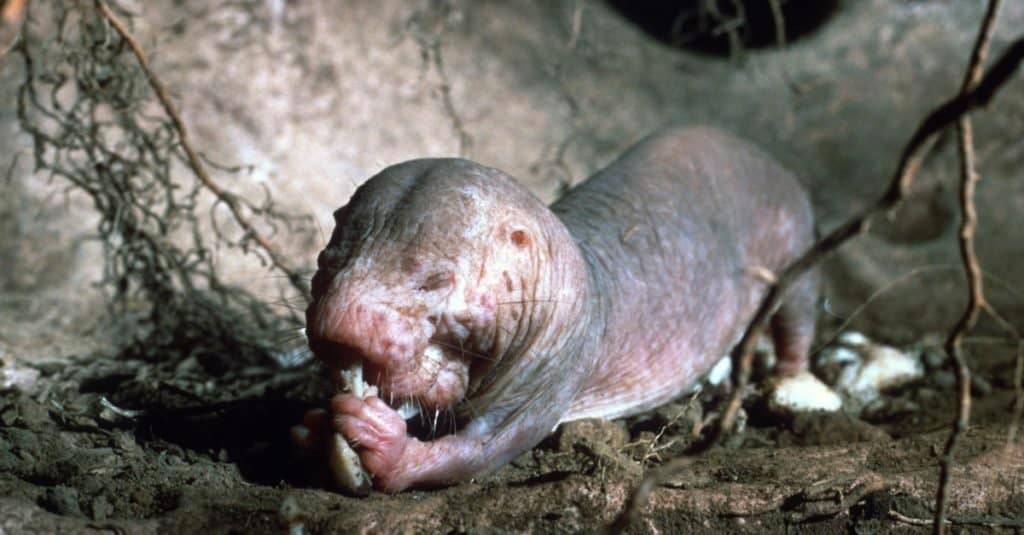Naked Mole Rat
Heterocephalus glaber
Naked mole rats don’t get cancer
Advertisement
Naked Mole Rat Scientific Classification
- Kingdom
- Animalia
- Phylum
- Chordata
- Class
- Mammalia
- Order
- Rodentia
- Family
- Heterocephalidae
- Genus
- Heterocephalus
- Scientific Name
- Heterocephalus glaber
Read our Complete Guide to Classification of Animals.
Naked Mole Rat Conservation Status
Naked Mole Rat Facts
- Name Of Young
- Pup
- Group Behavior
- Colony
- Fun Fact
- Naked mole rats don’t get cancer
- Estimated Population Size
- Unknown, but they are of Least Concern
- Biggest Threat
- None
- Most Distinctive Feature
- They’re mammals but live much like social insects.
- Other Name(s)
- Sand puppy
- Gestation Period
- 70 days
- Litter Size
- 3 to as much as 28 pups
- Habitat
- Underground
- Predators
- Snakes and birds of prey
- Diet
- Omnivore
- Favorite Food
- Tubers, roots, rhizomes, bulbs
- Type
- Mammal
- Common Name
- Naked mole rat
- Number Of Species
- 1
- Location
- the horn of Africa
- Group
- Colony, dominated by a queen
Naked Mole Rat Physical Characteristics
- Color
- Yellow
- Pink
- Skin Type
- Skin
- Lifespan
- As much as 32 years
- Weight
- 1.1 to 1.2 ounces, though queens can weigh 2.8 ounces
- Length
- 3 to 4 inches
- Age of Sexual Maturity
- 228 days for females, a year for males
- Age of Weaning
- One month
View all of the Naked Mole Rat images!
“A Naked Mole Rat is the world’s weirdest land animal.”
One of the amazing things about life on earth is that it takes many forms, even if those forms are weird to the human eye. One of the weirdest types of land animals must be a creature called the naked mole rat. It is a rodent but is neither a rat nor a mole. Nearly blind and mostly hairless, it spends much of its life underground in colonies comprised of 75 to 80 mole rats, though a colony can contain as many as 200 individuals. The life of the colony revolves around a queen, who is the only female who is allowed to breed.

5 Incredible Naked Mole Rat facts!
- The naked mole rat colony behaves more like a honeybee hive than a group of mammals. It is dominated by a matriarch or queen who is served by all the other members of the group. Like the queen bee, she’s the only female allowed to reproduce.
- The naked mole rat is basically cold-blooded, which means its body temperature depends on its surroundings.
- It has no pain receptors in its pink skin.
- Its metabolism is extremely low.
- The naked mole rat can live without oxygen for 18 minutes and live happily in an atmosphere of 80 percent carbon dioxide and 20 percent oxygen. It does this by accessing stores of fructose in its vital organs, including its brain. The naked mole rat is the only mammal that can do this.
Scientific name
The naked mole rat’s scientific name is Heterocephalus glaber. Heterocephalus means “two-headed” or “different-headed” in Greek and is used to describe a deformed fetus with two unequal heads as well as the genus the naked mole rat belongs to. It is possible that such a deformity occurred to the scientist who first took a look at the odd-looking animal. “Glaber” is Latin for smooth and hairless, though the skin of the naked mole rat is wrinkled and has no layer of fat beneath it. The naked mole rat is the only species in its genus.
Evolution And History
The naked mole rat, also known as the sand puppy, first began to appear around 24 million years ago, in the late Oligocene era. This mammal first diverged from other African mole rats more than 31 million years ago, during this period, to eventually become its own species. While they are closely related to blesmols and were previously classified in the same genus, they are so unique that they were given their own family and are still the only species of their kind.
While not much more is known about the history of this sand puppy, scientists are eager to study its biology for these mole rats lives an exceptionally long time and are highly resistant to cancer.
Appearance

Naked molerat in an underground chamber, feeding while using its dexterous paws to hold food. A quarter of a mole rat’s muscle mass is in its jaws.
©Neil Bromhall/Shutterstock.com
The naked mole rat is a small rodent with a cylindrical body and pinkish skin that’s almost completely hairless, though there are tiny, sensitive hairs over the body that let it know where it is in the darkness of its burrow. The mole rat also has hairs between its toes that let it sweep back the soil. There’s no insulating fat beneath the skin. Males and females are about the same size, though breeding males and the queen are larger. It has a tail of medium length, short legs, and proportionally large feet made for digging.
Since the naked mole rat lives most of its life in an underground burrow devoid of light, sight is useless, and its eyes are nearly vestigial, though they have thickened eyelids that keep the dirt out of them. The rodents have prominent, chisel-like teeth that identify them as rodents. They use these teeth, which can move independently of each other like scissors or chopsticks, to help them dig through the ground. An array of muscles make sure that the animal’s mouth remains closed behind its teeth so it doesn’t swallow the soil. Indeed, much of the somatosensory cortex in the sand puppy’s brain is dedicated to its teeth.
Behavior

Every naked Mole rat has its own odor which allows them to tell each other apart.
©Eric Isselee/Shutterstock.com
Since a sand puppy colony can’t distinguish day from night, it is active at all hours. Non-breeding mole rats do the work of the colony. They raise the pups after they’ve been weaned, find food, protect the borrow, and build molehills. As with certain types of bees and wasps, younger members take care of the young while older members serve as soldiers. The queen and breeding males do nothing much but procreate. The queen, who rather bullies all the other mole rats in her burrow, is always fed first. She produces hormones to suppress the reproduction of other females, and if she dies, older females in the colony will fight for dominance. Sometimes they fight to the death, and the winner takes over the colony.
When constructing the burrow, the animals form a line where the first one digs with its teeth, and the others push the loosened soil down to the last, who then deposits it above ground, building a molehill.
Every naked mole rat burrow has its own odor. This allows the members, who can’t see well, to tell their family members from strangers. Colonies also have their own vocalizations that warn of danger and let family members tell each other apart in the darkness. Naked mole rats need to huddle together to keep warm while they sleep, and they sleep on their backs. They also climb up into chambers closer to the surface that is warmed by the sun.
Naked mole rats live exponentially longer than other rodents. It is not unheard of for a mole rat to live 30 years or more, while the lifespan of a mouse is about three years. Moreover, they do not seem to age. No one can really say why, though their DNA is able to repair itself over time far more effectively than the DNA of mice.
Habitat
Naked mole rats build their burrows and tunnels in the savannahs and grasslands of east African countries such as Kenya, Somalia, and Ethiopia, though they’re also found in Tanzania and Uganda. The tunnels are about 6.5 feet deep, and since they branch off into other tunnels and chambers that serve as larders, toilets, and nests, they can be 2.5 miles long. Naked mole rat colonies are found in elevations of between 3608 and 9843 feet above sea level. Because they build their colonies in places that are of no agricultural interest to people, naked mole rats are largely left to themselves. Their strangeness also protects them, and they contribute greatly to Kenya’s ecotourism. They also live in zoos and protected areas.
Diet

Naked mole rats feed on underground parts of plants and roots.
©Neil Bromhall/Shutterstock.com
These animals feed on the underground parts of plants, such as tubers, rhizomes, bulbs, and roots. Some of these structures are very large and can feed a colony for years. The animals do not eat all of these underground structures but take some back to the burrow for storage. This allows the part of the plant to regenerate and for the colony to have food if the path to the plant is blocked. Blockages can occur if the soil becomes wet. The animal can digest the cellulose in its food thanks to bacteria found in its gut. Since they get all their water from their food, they don’t need to drink.
Sometimes these animals ingest their own feces. They also give feces to recently weaned pups. Scientists believe this action, called coprophagy, helps strengthen the bonds between family members. The hormones found in the feces of the queen, for example, may suppress the reproductive hormones of other female naked mole rats.
Predators And Threats
These animals are preyed upon by snakes that either grab them when they surface or are able to enter their tunnels. These snakes include the rufous beaked snake. Raptors, or birds of prey, can swoop down upon them while they are above ground. Toxins introduced into the food source can also harm naked mole rats.
Reproduction And Life Cycle

A Queen is the only one allowed to breed in a colony and usually gives birth to seven to eleven pups.
©Neil Bromhall/Shutterstock.com
The queen is the only one allowed to breed in a colony, though some colonies have two queens. She will mate with one to three males, even though in many cases they are closely related to her. These males are second in rank to her, and all non-breeding naked mole rats are ranked lower than they are. The queen will only mate with these larger, high-ranking males.
Just as the sand puppy can’t tell day from night, it has no breeding season, and the queen can breed all year. This means she can have as many as five litters a year. Her pregnancy lasts for around 70 days, and she usually gives birth to seven to eleven pups on average. A baby is tiny and weighs less than a penny. It is weaned in a little over a month before it enters into the care of lower-ranking mole rats. A baby also starts working for the colony when it’s about a month old and is batted about by older mole rats to get it used to a hard life.
If the queen dies, her consorts do not mate with the new queen. By the way, when a female becomes queen, she undergoes physical changes. Her spinal column stretches out, which allows her to sustain a pregnancy. This is what a baby naked mole rat might look like.
Though inbreeding is a hazard in a colony, scientists have discovered types of mole rats that they call dispersers. These mole rats will not mate with the queen and are generally not cooperative when it comes to maintaining the colony. Because of this, they seek to escape the colony when they can and find another with a queen who is not related to them.
Population
Scientists aren’t sure how many of these animals there are, but they are not endangered.
View all 65 animals that start with NNaked Mole Rat FAQs (Frequently Asked Questions)
What is a naked mole rat?
A naked mole rat is a rare and unusual eusocial rodent. This is a society where different generations live together, raise babies cooperatively and have breeding and non-breeding members who have different tasks.
What does a naked mole rat look like?
A naked mole rat, or sand puppy is small and pink, with basically hairless skin. Because there’s no fat beneath the skin, the skin is wrinkled.
What does a naked mole rat eat?
The naked mole rat eats underground plant material such as tubers and roos.
Where does a naked mole rat live?
The naked mole rat lives in grasslands and savannas in East Africa and is also found in zoos.
Can you keep a naked mole rat as a pet?
Naked mole rats really should not be kept as pets. Though they are very tough animals, they need a great deal of space and would need to be kept in some kind of climate-controlled habitat where they can dig very deep and have access to certain kinds of food. A person who wants a sand puppy as a pet will probably need to buy more than one. Because they are essentially cold-blooded, naked mole rats have to huddle to keep themselves warm as they sleep. They have also evolved to live in eusocial groups.
Thank you for reading! Have some feedback for us? Contact the AZ Animals editorial team.
Sources
- Wikipedia, Available here: https://en.wikipedia.org/wiki/Naked_mole-rat
- San Diego Zoo Wildlife Alliance Library, Available here: https://ielc.libguides.com/sdzg/factsheets/naked-mole-rat/population
- How Stuff Works, Available here: https://animals.howstuffworks.com/mammals/naked-molerat-oxygen-fructose.htm
- Animal Diversity Web, Available here: https://animaldiversity.org/accounts/Heterocephalus_glaber/#behavior
- Smithsonian’s National Zoo & Conservation Biology Institute, Available here: https://nationalzoo.si.edu/animals/news/10-things-you-didnt-know-about-naked-mole-rats

















